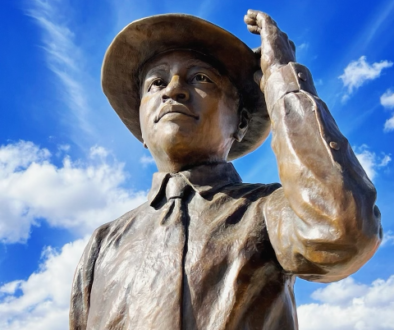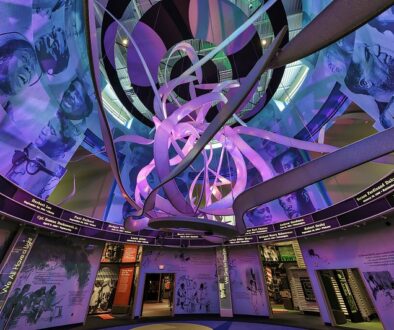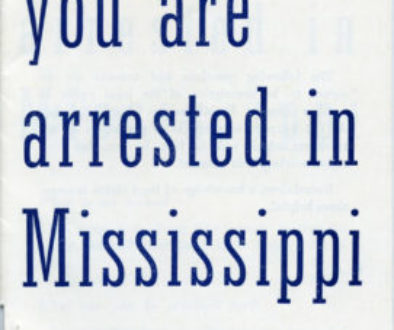The Help filming locations to visit in Greenwood and Jackson, Mississippi
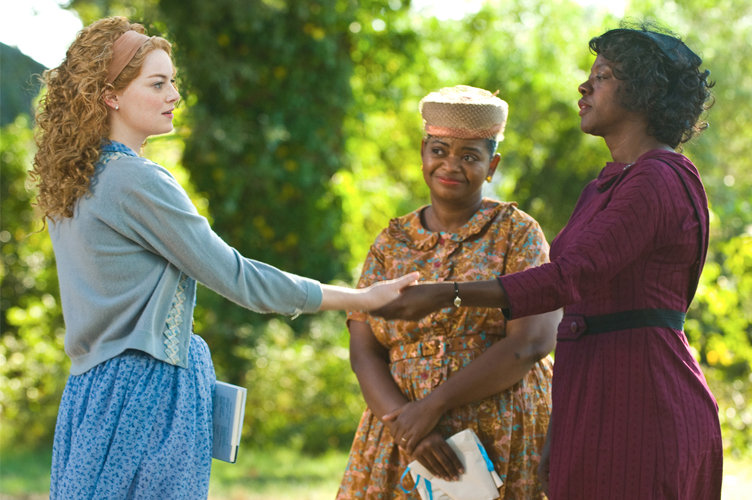
The film and best-selling novel The Help tells the story of Skeeter Phelan, a white Ole Miss graduate who collaborates on a secret writing project with the Black women who work as maids for white families in 1960s-era Mississippi.
While some have been wary of the story by University of Alabama graduate Kathryn Stockett because it depicts Black females in demeaning, stereotypical roles, others point to the compelling plot and the strong African-American characters.
Filming took place in Mississippi, and the main host cities – Greenwood and Jackson – are still eager to guide visitors to locations from the movie and novel. (Some scenes were also shot in Clarksdale and Greenville). Here’s how to visit The Help filming locations in Mississippi.
Greenwood, a historic Delta town with deep roots in cotton and the blues, is about 90 miles northwest of Jackson and distributes a map and guide to filming locations. The town plays 1960s-era Jackson in the movie. It’s also near a site linked to one of the most notorious and influential moments of the entire Civil Rights Era: the killing of teenager Emmett Till.
While only a few scenes were filmed in Jackson, the capital city has a detailed guide to sites mentioned in the book, from the Junior League headquarters to McDade’s Market.
Greenwood – Skeeter’s home and more
While most the filming sites in this town of 16,000 are on private property, a fan will definitely recognize city scenes, buildings, exteriors and landscapes. The film-makers liked the frozen-in-time look of the city – including gracious Southern buildings, and “modern” 1960s-era homes.
The major sites are below. Most are private property, so be respectful. You can find a Google map showing them all: here.
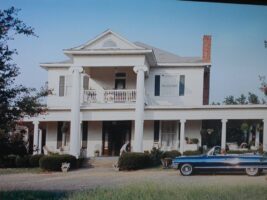
- Skeeter Phelan’s home was filmed in two places. The exterior of her farm house is Whittington Farm, at 7300 County Road 518 (Money Road). The interior of the home was the Franklin Residence, 613 River Road
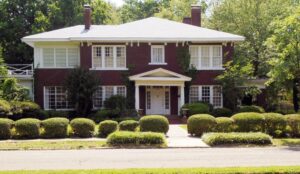
- Hilly Holbrook’s house: The Johnson residence at 413 Grand Blvd.
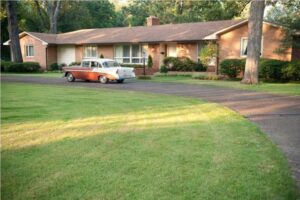
- The Leefolt Home: The Perkins residence at 1101 Poplar St.
- Aibileen Clark’s House: The Tims residence at 203 Taft Ave.
- Minny Jackson’s House / Bus Stop: In Baptist Town at the corner of Stephens Avenue and McCain Street
- Jackson Bus Stop: Little Red Park, East Adams and Poplar streets
- Constantine Jefferson’s Home: 1080 County Road 150, Greenwood.
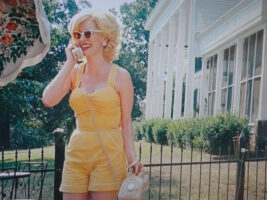
- Celia Foote’s House: Cotesworth, Old Grenada Road (north of Carrollton in Carroll County)
- Baptist Church: Little Zion M.B. Church, 63530 County Road 518 (Money Road), Greenwood. (Also the alleged burial site of blues legend Robert Johnson).
- Robert E. Lee Hotel: Exterior: Leflore County Courthouse, 306 W. Market St. Interior: Old Greenwood Elks Lodge, 102 W. Washington St..
- Avent & Clark Booksellers: A Pocket Full of Posies, 309 Howard St.
- Junior League of Jackson: Mississippi Garden Club Headquarters, 401 E. Market St.
Greenwood’s historic civil rights sites
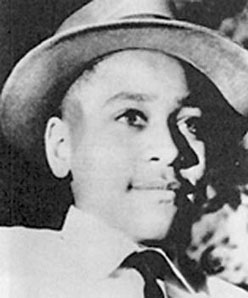
Greenwood is located about 10 miles south of Money, one of the notorious spots in U.S. Civil Rights history. It’s the site of Bryant’s Grocery and Meat Market, which is linked to the 1955 murder of teenager Emmett Till. The boy’s crime? Whistling at a white woman, Carolyn Bryant, at the store. Two days later the 14-year-old boy was dragged from his great-uncle’s home and brutalized. His body was later found in the Tallahatchie River. Bryant’s husband and his half-brother were charged with the crime, but acquitted by an all-white jury. Later, they confessed.
Till was visiting from Chicago, and his mother insisted that the funeral have an open casket. Pictures of her son’s mutilated body were seen around the world. The public was outraged and some link Till’s death to the start of the modern Civil Rights Movement. The casket is now displayed at the Smithsonian African-American History Museum, and is one of the most moving exhibits in Washington.
The grocery store has been left as a ruin, and the historic marker has been repeatedly vandalized over the year. But it’s definitely worth the drive to visit a tiny crossroads that changed history.
Greenwood itself has a checkered civil rights past. It’s the birthplace of the White Citizens’ Council, which formed in 1955 to fight desegregation and quickly spread throughout the South. It was considered more socially acceptable than the Ku Klux Klan, often acting behind the scenes with businesses and government.
Greenwood Guidebook
Greenwood has a surprising array of attractions, and civil rights tour. For more city info, visit the tourism bureau. Find Mississippi travel info here.
Many people come from across country to attend the celebrated cooking school run by Viking Range Corp.
TurnRow Books, an independent book store, was a daily hangout for the film’s directors and producers. The store often has signed copies of The Help, a great souvenir of your visit.
If you want to sleep where the stars stayed, try the Alluvian, a boutique hotel renovated by the local Viking Range Corp. It has won national attention for design, and the Mississippi art gracing the walls. The Thursday night happy hour was a favorite with the Hollywood visitors. The hotel’s also home to Giardina’s, a famed Creole-Italian restaurant serving diners since 1936.
Jackson
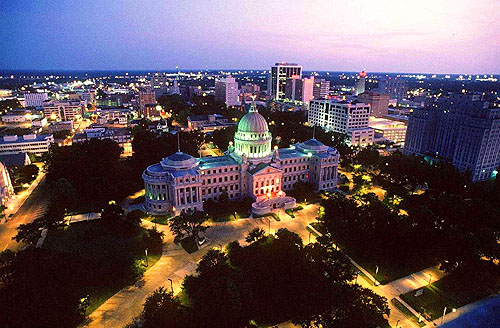
Jackson has been eager to embrace its role in The Help. It has maps and tour routes for fans of the novel, which has been a book-club staple for several years now.
The story’s set in Jackson’s historic Bellhaven neighborhood. Although a work of fiction, many of the sites in the book are real. Click here for a detailed driving tour of the neighborhood sites tied to the novel. This link provide a tour of other Jackson sites from the novel.
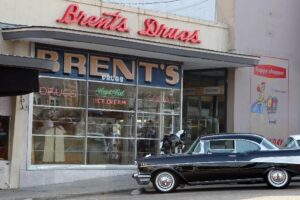
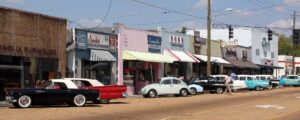
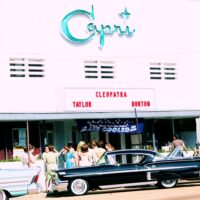
And here are all the sites on a Google map, below.
Jackson’s Civil Rights Sites
Jackson is worth a visit alone for its comprehensive and stirring Mississippi Civil Rights Museum. It’s modern and interactive , with films narrated by Oprah Winfrey and exhibits that will make you stop in your tracks. You can (and should) easily spend a couple hours here.
Medgar Evers’ shocking murder provides a backdrop to Jackson’s troubled racial climate in The Help.
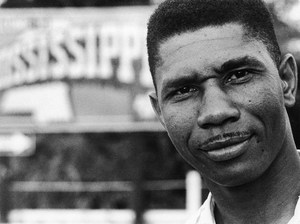
Other than the museum, the city’s most important civil rights location is the site of Medgar Evers‘ assassination. The field secretary for the NAACP was shot in his driveway in 1963 hours after President John F. Kennedy gave a speech supporting integration , reacting to Alabama governor George Wallace’s defiant “Stand at the Schoolhouse Door” earlier that day, when he tried to block Black students from enrolling at the University of Alabama in Tuscaloosa. The event, mentioned in The Help, made headlines around the world.
Evers helped lead a boycott against white Jackson merchants, and was a key player in James Meredith’s integration of the University of Mississippi (Ole Miss), which outraged many white Mississippians. Evers, who served in the U.S. Army, was buried at Arlington National Cemetery in Virginia.
Evers’ assassin, Byron De La Beckwith, a member of the White Citizens’ Council, was twice tried and freed when juries were unable to reach a verdict. In 1994, charges were brought again and he was convicted.
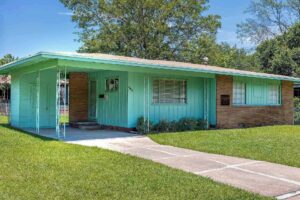
Evers’ home, 2332 Margaret Walker Alexander Drive, was recently marked with a Mississippi historic marker. Visitors will notice it does not have a front door. The Evers family thought it would be safer to have an entrance through the carport. Tours of the home are by appointment. To schedule a visit , call 601-977-7839 or 601-977-7710 or email mwatson@tougaloo.edu. Or take a virtual tour below.
You’ll also find a Mississippi historic marker at Jackson’s old Greyhound bus station, 219 N. Lamar Street, where protesters were methodically arrested during the Freedom Rides of 1961.
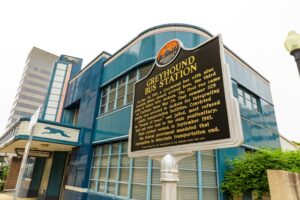
Jackson Guidebook
See more Jackson sites here.
For more information on Jackson, see Visit Jackson‘s online guide, including a comprehensive, downloadable civil rights driving tour.
Dining
For an authentic taste of the South, try a pig ear sandwich from the Big Apple Inn in Jackson’s Farish Street Historic District.
Or try the equally famous blackberry cobber from Bully’s Soul Food.
You’ll find authentic flavors of Africa at Sambou’s African Kitchen, a James Beard Award nominated eatery that features Gambian cuisine.
Jackson offers some top dining options, which mix Southern cooking with modern techniques. Many are in or near the Bellhaven neighborhood.
Favorites include: Elvie’s and Walker’s Drive-Inn, both upscale, James Beard-honored restaurants; Saltine, a fun oyster bar in a former school building; and Manship Wood Fired Kitchen, which combines Southern and Mediterranean flavors.
Lodging

For a treat, “Help” fans may want to splurge for a stay at the historic Fairview Inn, which housed the cast during filming, and makes an appearance on page 148 of the book. If nothing else, try to stop by for their Sunday brunch.
You’ll find a full array of chain hotels, including the top ranked Hilton Garden Inn Jackson Downtown, in a restored office building


